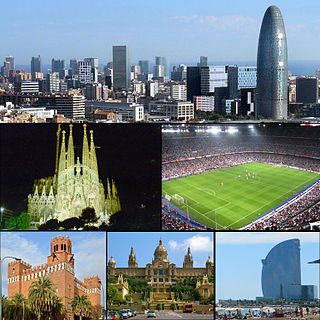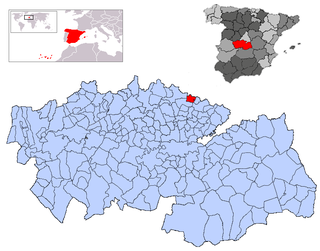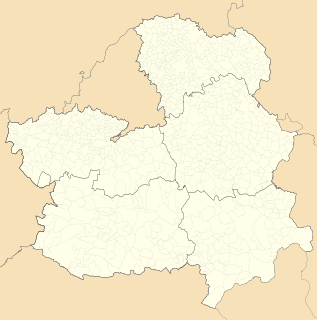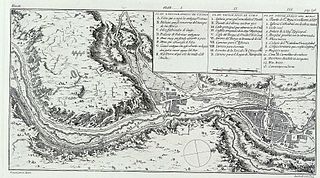 W
WAbyla was the pre-roman name of Ad Septem Fratres. Ad Septem Fratres, usually shortened to Septem or Septa, was a Roman colony in the province of Mauretania Tingitana and a Byzantine outpost in the exarchate of Africa. Its ruins are located within present-day Ceuta, an autonomous Spanish city in northwest Africa.
 W
WAcci was an ancient inland city of Hispania Tarraconensis, on the borders of Baetica. Under the Romans, and with the Jus Latinum, it was a colony with the full name of Colonia Julia Gemella Accitana. Its coins are numerous, bearing the heads of Augustus, Tiberius, Germanicus, Drusus, and Caligula, and the ensigns of the legions iii. and vi., from which it was colonized by Julius Caesar or Augustus, and from which it derived the name of Gemella. According to Macrobius, Mars was worshipped here with his head surrounded with the sun's rays, under the name of Netos. Such an emblem is seen on the coins. The town became Christian at an early date; the Diocese of Acci was established in 47 AD. The bishop is no longer resident in the uninhabited site, but Acci remains a titular see of the Roman Catholic Church.
 W
WAlcalá de Henares is a Spanish city in the Community of Madrid. Straddling the Henares River, it is located 35 kilometres to the northeast of the centre of Madrid. As of 2018, it has a population of 193,751, making it the region's third-most populated municipality.
 W
WArjona is a municipality in the province of Jaén, Andalusia, Spain. It is located 44 kilometres (27 mi) from the provincial capital, Jaén, and 77 kilometres (48 mi) from the city of Córdoba. As of 2017, it had a population of 5,662 and it has an area of 158.45 square kilometres (61.18 sq mi). It belongs to the comarca of Campiña. Its land area is primarily agricultural, with an emphasis on olive trees. Its economy relies primarily on agriculture and olive oil production, but it is also known for its furniture and baking industries. Arjona is known as the birthplace in 1194 of Muhammad I of the Emirate of Granada.
 W
WAugusta Emerita, also called Emerita Augusta, was a Roman Colonia founded in 25 BC in present day Mérida, Spain. The city was founded by Roman Emperor Augustus to resettle Emeriti soldiers from the veteran legions of the Cantabrian Wars, these being Legio V Alaudae, Legio X Gemina, and possibly Legio XX Valeria Victrix. The city was the capital of the Roman province of Lusitania, and was one of the largest in Hispania with an area of over 20,000 square kilometres (7,700 sq mi). It had three aqueducts and two fora.
 W
WBarcelona is a city on the coast of northeastern Spain. It is the capital and largest city of the autonomous community of Catalonia, as well as the second most populous municipality of Spain. With a population of 1.6 million within city limits, its urban area extends to numerous neighbouring municipalities within the Province of Barcelona and is home to around 4.8 million people, making it the fifth most populous urban area in the European Union after Paris, the Ruhr area, Madrid, and Milan. It is one of the largest metropolises on the Mediterranean Sea, located on the coast between the mouths of the rivers Llobregat and Besòs, and bounded to the west by the Serra de Collserola mountain range, the tallest peak of which is 512 metres high.
 W
WAugusta Bilbilis was a city founded by the Romans in the province of Hispania Tarraconensis. It was the birthplace of famous poet Martial c. 40 AD. The modern town of Calatayud was founded near this Roman site.
 W
WBolskan was an iberian city located in the territory of the Vescetani in NE Spain c. 65 km North of the Ebro river and lies upon the site now occupied by the modern city of Huesca, in the Iberian Peninsula.
 W
WCarranque is a town in the Toledo province, Castile-La Mancha, Spain. It is located in the area of the province bordering the province of Madrid called the Alta Sagra.
 W
WCarteia was a Phoenician and Roman town at the head of the Bay of Gibraltar in Spain. It was established at the most northerly point of the bay, next to the town of San Roque, about halfway between the modern cities of Algeciras and Gibraltar, overlooking the sea on elevated ground at the confluence of two rivers, nowadays called Guadarranque and Cachon.
 W
WCelsa was an important pre-Roman and Roman city located near the modern town of Velilla de Ebro.
 W
WClunia was an ancient Roman city. Its remains are located on Alto de Castro, at more than 1000 metres above sea level, between the villages of Peñalba de Castro and Coruña del Conde, 2 km away from the latter, in the province of Burgos in Spain. It was one of the most important Roman cities of the northern half of Hispania and, from the 1st century BC, served as the capital of a conventus iuridici in the province Hispania Tarraconensis, called Conventus Cluniensis. It was located on the road that led from Caesaraugusta (Zaragoza) to Asturica Augusta (Astorga). The city declined during the 3rd century and was largely abandoned by the Visigothic era. Clunia is a toponym of Arevacian origin.
 W
WErcavica was an important Roman City whose remains are visible today at the archaeological site. It is situated on the hill of Santaver near Cañaveruelas in Spain.
 W
WAlcaudete is a city located in the province of Jaén, Andalusia, Spain. As of 2018, it has a population of 10,558. It is home to a 12th-14th century Moorish castle, located on the top of the hill commanding the town. Other sights include the Iglesia de Santa María la Mayor.
 W
WItalica north of modern-day Santiponce, 9 km northwest of Seville in southern Spain, was an Italic settlement founded by the Roman general Scipio in the province of Hispania Baetica. It was the birthplace of Roman Emperors Trajan, Hadrian, and Theodosius (possibly). It flourished under the reign of Hadrian, becoming an elaborate urban centre and obtaining the highest status of Roman city. The modern town of Santiponce overlies the pre-Roman Iberian settlement and part of the well-preserved Roman city.
 W
WIulia Traducta was a Roman city in Andalusia, Spain, on the site of the modern Algeciras.
 W
WJuliobriga (Spanish: Julióbriga, was the most important urban centre in Roman Cantabria, as stated by numerous Latin authors including Pliny the Elder. The site has traditionally been identified with ruins in the village of Retortillo and its Villafría district, in the municipality of Campoo de Enmedio.
 W
WLas Médulas is a historic gold-mining site near the town of Ponferrada in the comarca of El Bierzo. It was the most important gold mine, as well as the largest open-pit gold mine, in the entire Roman Empire. Las Médulas Cultural Landscape is listed by UNESCO as a World Heritage Site. Advanced aerial surveys conducted in 2014 using LIDAR have confirmed the wide extent of the Roman-era works.
 W
WLlíria is a medium-sized town off the CV35 motorway to the north of Valencia, Spain. Known as Edeta in ancient Iberian times, it is the musical capital of the region. On October 30 2019, Llíria was declared a Creative City in the category of Music by the UNESCO.
 W
WLucentum, called Lucentia by Pomponius Mela, is the Roman predecessor of the city of Alicante, Spain. Particularly, it refers to the archaeological site in which the remains of this ancient settlement lie, at a place known as El Tossal de Manises, in the neighborhood of Albufereta.
 W
WMérida is a city and municipality of Spain, part of the Province of Badajoz, and capital of the autonomous community of Extremadura. Located in the western-central part of the Iberian Peninsula at 217 metres above sea level, the city is crossed by the Guadiana and Albarregas rivers. The population is 60,119 in 2017.
 W
WMontoro is a city and municipality in the Córdoba Province of southern Spain, in the north-central part of the autonomous community of Andalusia.
 W
W| coordinates = 37°42′47.3″N 5°44′26.17″W
 W
WNumantia was an ancient Celtiberian settlement, whose remains are located 7 km north of the city of Soria, on a hill known as Cerro de la Muela in the municipality of Garray.
 W
WOiasso, Oiasona or Oiarso was a Basque Roman town located on the left bank of the Bidasoa estuary in the Bay of Biscay. Archaeological evidence unearthed recently pinpoints the core area of Oiasso in the old quarter of Irun (Gipuzkoa) by the Spanish-French border, where harbour and bath remains have been discovered. However, two other focuses in Cape Higuer and hermitage Ama Xantalen point to a wider complex outside the main nucleus.
 W
WPollentia was a Roman city founded by Quintus Caecilius Metellus Balearicus in the present city of Alcúdia, allegedly in the year 123 BC. The first documented remains belong, however, to the first half of the 1st century BC. This had led the researches to establish the possibility of the creation of a castra by the military expedition that, a generation later, would derivate in the current city of Pollentia.
 W
WSagunto ([saˈɣunto] is a city in Eastern Spain, in the modern fertile comarca of Camp de Morvedre in the province of Valencia. It is located c. 30 km north of Valencia, close to the Costa del Azahar on the Mediterranean Sea.
 W
WSegóbriga was an important Celtic and Roman city, and is today an impressive site located on a hill near the present town of Saelices. Research has revealed remains of important buildings, which have since been preserved and made visible in the Archaeological Park. It was declared a National Monument on June 3, 1931, and is now considered cultural heritage under the official denomination Bien de Interés Cultural which comes with extensive legal protections.
 W
WAlcaudete is a city located in the province of Jaén, Andalusia, Spain. As of 2018, it has a population of 10,558. It is home to a 12th-14th century Moorish castle, located on the top of the hill commanding the town. Other sights include the Iglesia de Santa María la Mayor.
 W
WTarraco is the ancient name of the current city of Tarragona. It was the oldest Roman settlement on the Iberian Peninsula. It became the capital of the Roman province of Hispania Citerior during the period of the Roman Republic, and of Hispania Tarraconensis following the latter's creation during the Roman Empire.
 W
WTermantia, the present-day locality of Tiermes, is an archaeological site on the edge of the Duero valley in Spain. It is located in the sparsely populated municipio of Montejo de Tiermes.
 W
WToledo is a city and municipality of Spain, capital of the province of Toledo and the de jure seat of the government and parliament of the autonomous community of Castilla–La Mancha. Toledo was declared a World Heritage Site by UNESCO in 1986 for its extensive monumental and cultural heritage.
 W
WUxama Argaela was a Celtiberian, and subsequently Roman, city located on El Castro hill, overlooking the present town of El Burgo de Osma in Soria, Spain.
 W
WValeria was an important Roman city and one of the three major cities in the modern province of Cuenca.
 W
WVeleia was a Roman town in Hispania, now located in the Basque Autonomous Community, Spain. The site is located in the municipality of Iruña de Oca, 10 kilometers west of Vitoria. The town was an important station on the Roman road ab Asturica Burdigalam that ran parallel to the coast of the Bay of Biscay. At its apogee, the city could have been inhabited by some five to ten thousand people, and apparently went through different cycles of prosperity and decline into the Early Middle Ages until it was finally abandoned.
 W
WZaragoza is the capital city of the Zaragoza province and of the autonomous community of Aragon, Spain. It lies by the Ebro river and its tributaries, the Huerva and the Gállego, roughly in the center of both Aragon and the Ebro basin.